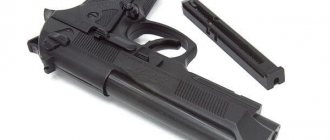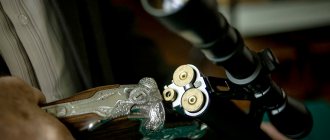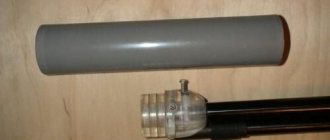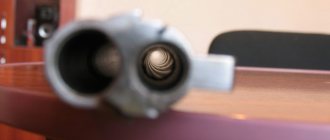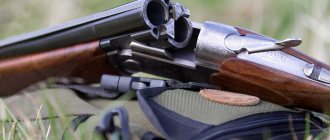It is quite obvious that we will be talking about a weapon with which you can make an unnoticed shot. Silent prototypes have been known around the world for more than 100 years. But the narrow range of applications and the secrecy of the project brings many tales about these mechanisms.
Any weapon equipped with a special device to reduce sound levels is called silent. Or, as they say in the modern world, with suppressed sound. Moreover, this term is conditional, since it is impossible to fire a shot completely without sound. How a weapon silencer works began to be studied back in the 19th century, after the advent of smokeless gunpowder. At the same time, two methods of sound suppression were immediately identified: cutting off the gases from the combustion of gunpowder and blocking them in the barrel, and pre-increasing and cooling the gases before release into the atmosphere.
Firearms appeared several centuries ago and sound was considered the norm until our century. The roar of firing was accompanied by thunderous noise, sparks and haze. And all this was considered an indicator of good weapons.
In the modern world, silencers are used not only by the military, but also by hunters and athletes. Over its long history, it has been modernized and optimized many times.
The history of the creation of “silent” weapons
The very first attempts to create a device to reduce shooting noise were made a couple of years after the invention of smokeless gunpowder. Since the appearance of the shot had disappeared, it became necessary to reduce the sound. The first suppressors came out at about the same time. Registered in Sweden in 1894. In 1898 it was invented by France. In 1899, Denmark patented its multi-chamber suppressor. But for mass production, a device was used that was patented by British gunsmiths at the beginning of the 20th century.
Guerrilla "silence"
The Bramit device for silent and invisible shooting was developed shortly before the start of the Great Patriotic War . With the outbreak of hostilities, “Bramites” were primarily armed with sabotage and partisan detachments operating behind enemy lines. Throughout the war, documents on this development were classified “Top Secret”. When did a top-secret Soviet device cease to be so for the enemy?
In the hands of the enemy
Despite all the secrecy surrounding the Bramit in the Soviet Union, soon after the start of the war it fell into the hands of the Finns and Germans as a trophy. Thus, in the German reference book of infantry weapons Kennblätter Fremden Geräts
a Soviet captured silencer is described, which is designated
Schalldämpfer 254 (r)
.
The model 1891/30 rifle (Mosin) with a silencer in the same source is called Partisanengewehren
(“partisan rifle”).
These descriptions were compiled on June 1, 1942, but even earlier, the Finnish infantry ammunition manual Jalkaväen Ampumatarvikkeet
, dated February 20, 1942, talks about special ammunition and a silencer for the Mosin rifle. Already in April of the same year, the Finns launched into mass production a copy of the Soviet Bramit muffler.
The design of the Bramit device Jalkaväen Ampumatarvikkeet, 02/20/1942
It is clear that the secret device fell into the hands of the enemy even earlier, but the circumstances of this event were not reliably known for a long time. Not long ago, Soviet documents appeared in the public domain, which are translations from German of captured logistics documents that fell into the hands of Soviet specialists in May 1942. From one such German order it becomes clear that already at the beginning of October 1941 the enemy knew that “the Russians, especially the partisans, use rifles with sound suppressors.”
.
The Germans knew both about the design of the device (“a bushing, inside of which there are two rubber plugs located one behind the other”
), and about the peculiarities of the marking of cartridges
(“special ammunition, the bullets of which are painted green”
), and when they were discovered, the soldiers and officers they were ordered to be sent to the weapons and technical equipment departments.
Partisan training
However, let's return to the beginning of the Great Patriotic War. In the first months of hostilities, the partisan movement was just gaining momentum and was rather unorganized. To intensify anti-fascist resistance behind enemy lines, already in July 1941, the Operational Training Center of the Western Front was created, headed by the “chief Soviet saboteur” Ilya Starinov. At the same time, similar partisan schools began to open in many front-line cities under the leadership of local party workers. Troops of the Special Group of the NKVD of the USSR were also formed, where reconnaissance and sabotage groups were also trained.
Such schools recruited exclusively volunteers. These were mainly military personnel who had escaped encirclement, fallen behind the combat units, or were left without equipment. Considering the rapid advance of the front deep into the country, the duration of training for such groups in the first months of the war was only about ten days. The cadets studied sabotage equipment, guerrilla tactics, and the main purpose of sabotage activities was to blow up bridges, destroy military warehouses and attack columns. Training was also carried out in shooting rifles with special armor-piercing cartridges and silent Bramit devices, and the design of Dyakonov grenade launchers, of which there were three for each squad, was studied. Subsequently, on the basis of many such sabotage groups, partisan detachments began to form in the Belarusian forests.
Partisans, armed, among other things, with Bramits. Photo from the collection of Natalia Filippova
Despite the wide popularity of sound suppression devices, it was Soviet intelligence officers and partisans who were the first to use them en masse to carry out special missions. Next we will talk about one of the episodes that significantly influenced the further possibility of the sudden use of silent weapons in the German rear.
Failure of saboteurs
At the beginning of August 1941, near Moscow, in one of the partisan training schools, a group of future saboteurs successfully completed a ten-day course. Before being sent to enemy lines, a high-ranking general spoke to the graduates, who announced that they “ being awarded weapons, the existence of which neither the generals, nor the officers and not a single Red Army soldier at the front knew anything about.”
.
Moreover, saboteurs “should rather let themselves be shot than tell the enemy anything about this weapon and under no circumstances give it to the enemy
. ”
The sabotage group's armament was approximately this: three people with submachine guns, seven people had rifles with sound suppressors, each had a Nagant revolver, six fragmentation hand grenades, 300 special and 180 incendiary cartridges. To allow the group to split into two sections, it had two commanders, four soldiers and four civilians. One of these groups was sent to the area of the city of Polotsk, Vitebsk region.
Instructions for using "Bramita" classified as "Top Secret" by TsAMO RF
Probably, this group allowed itself to be discovered 10 km from Polotsk, north of the Polotsk-Vetrino road. As it should be in such a situation, in order to avoid falling into the hands of the enemy, the Bramit devices, along with the rest of the weapons, were buried in a swampy forest. Further events followed an unforeseen scenario: the entire partisan group, with the exception of the commander, surrendered, and “prisoner of war Ivan Ts., in gratitude for the good treatment he received
, volunteered to testify about the training of partisans and silent weapons of the new type
. ” Perhaps it was from his testimony that the enemy first learned about the partisans' secret weapons. Later, in June 1942, the interrogation documents were captured by partisans.
So, on September 6, 1941, after the testimony of a Soviet prisoner, soldiers of the German 403rd rear security division discovered buried in the forest:
“4 Russian infantry rifles;
2 silencers with 4 spare rubber bushings;
4 belts with 6 egg-shaped combat hand grenades on each;
5 blank egg-shaped hand grenades;
165 charges of “special ammunition” with a green bullet and the same cartridge bottom;
200 charges of “incendiary ammunition”, the projectile heads are black with a red border;
1 notebook with chemical formulas and separate instructions on the composition of homemade incendiary agents, explosives, etc.”
The only things that could not be found were submachine guns, as well as Soviet and German money. The prisoner also argued that “ with a sound suppressor attached, only “special ammunition” can be used, because when using other ammunition, the rubber bushing is destroyed by the first shot, and when firing with “special ammunition” the rubber bushings must withstand 100 shots.”
.
Immediately, at the division headquarters, ammunition and a sound suppressor were tested. ABOUT
.
After this, the division headquarters sent the superiors in a separate package “1 sound suppressor, 2 spare rubber bushings and 76 charges of “special ammunition””
. Most likely, this was exactly the way the secret Soviet device got onto the pages of the German manual.
Fragment of a German manual with a captured Soviet muffler Kennblätter Fremden Geräts, 06/01/1942
Further, in the order of the head of the rear region of the Central Front No. 51 dated September 11, 1941, the following instructions are given: “As has been established most recently, the partisans use a sound suppressor mounted on firearms and special cartridges, when fired with which you can only hear the strike of the firing pin and a quiet hissing sound"
. A little later, such German instructions as “Special Instructions for Combating Partisans” and “Manuals for Combating Partisans” quickly appear, which also indicate the use of rifles with sound suppressors by partisans.
Mass release
Despite sometimes unsuccessful operations behind enemy lines, which entailed serious negative consequences, the use of such special weapons by the partisans was extremely successful. Thus, one of the representatives of the Central Headquarters of the Partisan Movement (TSSHPD) in July 1942 reported from the Bryansk forests to his leadership:
“Send devices for silent shooting to machine guns, SV-40, PPD and PPSh assault rifles, as well as cartridges for them. The effect they have here is enormous. Railway section cleared of security for 2-3 hours completely. Therefore, delayed-action mines and Bramit devices are very, very necessary here »
And they actually sent silencers to the partisans. Thus, by July 1943, more than 3,000 Bramit devices, almost 40,000 rubber seals, and over 1,200,000 special cartridges arrived at the warehouses of the Belarusian Headquarters of the Partisan Movement (BSHPD). Silencers were not only for rifles, but also for Nagan revolvers. There were practically no separate records of rifle and revolver Bramits, so it is not yet possible to find out how many rare pistol silencers the partisans had. For example, at the beginning of 1944, there were 315 rifle and 18 Bramit revolver devices at the Vnukovo airfield. And what kind of cartridges the partisans fired from the silent revolver still remains a mystery.
Guerrilla silencers "Bramith" from the exhibition of the Belarusian State Museum of the History of the Great Patriotic War. Photo by the author
Little is known about the production of Bramits before the start of the war and in its first years. In besieged Leningrad in 1941, at least 5,000 of these devices were produced, while mass production was launched only in May 1942 in accordance with GOKO decree No. 1634ss of April 23, 1942. From May to July, two defense factories planned to produce 50,000 silencers, of which 7,500 were intended for the NKVD troops. However, until December 1942, Plant No. 536 (Tula Arms) produced just over 50,000 pieces, and then stopped production. The second enterprise to produce Bramits was plant No. 621, which produced such products until mid-1944 (data on their production has not yet been found). From the second quarter of 1943, the Bramit production plan was sharply reduced (to only 500 units per month). Thus, the number of mufflers produced over the entire period can reach an impressive number of 100,000 pieces for a special product.
Now we can confidently state that the Bramit device was the most popular muffler of that time. Later, the Red Army adopted the SG-DP silencer for a machine gun of a similar design, which was also intended to supply partisan detachments. Silent submachine guns PPD-Bramit, intended for special units of the Red Army and partisan detachments, were also tested. In addition, the development of the Gurevich silent pistol was under the control of the BSPD in 1943. However, it was the Bramit rifle designed by the Mitin brothers that became that indispensable partisan “silent” or “silent” weapon.
Sources:
- TsAMO RF, fund 500, inventory 12480, file 262
- RGASPI, fund 644, inventory 2, file 53
- NARB, fund 1450, inventory 1, file 20
History of development
In Russia, the first patented suppressor appeared in 1916, thanks to the developments of the gunsmith-engineer A. Ertel. But it couldn’t get much demand, since it was used preferably for an artillery gun. But the device gained its greatest popularity around 1920, due to its popularity not with the military, but with hunters. They were the very first to realize the importance of silent shooting. And literally 10 years later this device was banned for use by civilians. Due to high demand not only in hunting, but also in criminal cases of citizens.
In the modern world, many countries have allowed the use of a suppressor in hunting and sport shooting. This is what increases the demand for new models. All production is aimed at minimizing the sound of firing, while improving the quality of accuracy and speed of fire. But still, to purchase this device, you need a purchase permit with a medical examination.
Does a homemade muffler made from a plastic bottle work?
Sometimes in Hollywood films you can see scenes where militants use homemade mufflers from a bottle, which, apparently, work no worse than the factory body kit. Is it possible to build such a device with your own hands? This is a question that many hunters have asked. After all, buying an expensive “body kit” in a store seems like an unaffordable luxury, especially if the muffler can be made at home from scrap materials. But is this really so?
Let's start with the main thing - yes, it is possible to make a muffler from a bottle, and yes, it will work no worse than its store-bought counterpart. But in addition to beer or mineral water containers, you will also need a fairly dense material that will cope well with the retention of powder gases. And if you think that ordinary cotton wool or polyurethane foam will be suitable for this purpose, then you are deeply mistaken. But even if you find a suitable material, such a muffler will still not be enough for a long time - over time it will begin to absorb gases worse and worse.
Is it worth reminding that for using a homemade silencer, a hunter will almost certainly face not only a fine, but also the confiscation of his weapons license or even a ban on purchasing it in the future. So if you decide to sculpt silencers from Chernogolovka at home without stopping, then it’s better to leave this idea to the action movie scriptwriters. No amount of savings is worth losing your license, especially since you can legally purchase silencers for 5-7 thousand rubles and for almost any caliber.
Advantages and disadvantages
This device has very few disadvantages:
- price;
- difficulty of design;
- difficulty in obtaining permission to purchase (confirmation of use by type of activity is required.
- But there are many more advantages that can be identified:
- weapon balancing;
- high maneuverability;
- ergonomics;
- significant reduction in shot noise;
- muzzle brake compensator function
- increased strength;
- Style (a weapon equipped with a suppressor looks more powerful).
About technical specifications
This type of weapon has the following technical characteristics:
- The type of IED is a sniper rifle.
- In service since 1994.
- The weight of the weapon, equipped with optics and without ammunition, is 5.9 kg, with the DS5 night vision complex and empty ammunition - 6.1 kg.
- The total length of the rifle is 98 cm, the barrel is 52 cm.
- Shooting is carried out with 7.62 x 64 mm R and NATO 7.62 x 51 mm cartridges.
- The weapon functions by removing powder gases.
- Within one minute, 30 shots can be fired from an IED. For SVU-A and SVU-AS this figure is increased to 650.
- Using an SVD with a silencer, you can hit a target at a maximum range of up to 1300 m. Aimed fire is possible at a distance of no more than 800 m.
Muffler device
The standard version of the device has a classic look. This is a muzzle mechanism that is applied to various variations of firearms. It is fixed on the barrel or is a continuation of the design provided by the manufacturer. The main task of the device is to reduce the sound level and reduce the volume of fire from the combustion of gunpowder, to ensure the shooter's secrecy.
This feature is very important for military operations, because there is no particular need for a hunter in the forest or a shooter in the field to hide. And for a military man, it is very important not so much to reduce the noise of shooting as to hide sparks and flashes in the dark. With the help of flashes of light, the shooter is very easy to detect and will become an excellent target for the enemy. The suppressor also has a number of useful advantages, such as shooting intensity. There is also minimal gun recoil.
The suppressor looks like a cylinder made of metal materials: steel, copper, aluminum, a durable plastic mass can be used. Inside it there are cells in which the powder gas is removed. Most often, the device is attached to the end of the barrel using a special thread.
At the instant of the shot, gases penetrate the compartments and lose speed in them.
The chambers can also be filled with materials that absorb heat: aluminum mesh or shavings, copper wire. In this case, the gases cool themselves when the filler is heated and reduce their pressure. But such fillers are difficult to clean and are simply replaced. The noise level can also be affected by the material from which the partitions are made. If you replace steel parts with aluminum ones, the sound of shooting will be significantly lower. But such designs also have disadvantages. During a long series of shots, the pressure in the compartments increases, the cooling parts heat up and the productivity of the mechanism decreases. Subsequently, the main task and benefit of the device will be lost. Designers advise firing one salvo at a time with a large period of time between them so that the structure has time to cool down.
Silencers or closed type DTK
Recently, more and more closed-type DTKs have begun to appear on the market, which not only reduce recoil or eliminate flames, but also reduce the noise of the shot to comfortable levels. However, according to all the documentation, such a device is not classified as a silencer, so it can be safely used on civilian weapons. Well, the fact that in addition to its main task, a muzzle brake-compensator also leads to a decrease in the noise level from a shot, is presented to everyone as a “side effect” that cannot be eliminated.
The funny thing is that this scheme for circumventing the law not only works, but also, apparently, suits not only hunters, but also members of the government. After all, amending the Federal Law to give a clearer definition of what a muffler is is a matter of a few weeks. Apparently, the state is simply not interested in prohibiting hunters and sportsmen from using devices to eliminate gunshot noise. True, in this case, it is not clear why there was a need to ban anything at all, if in European countries the use of silencers is not only prohibited, but also encouraged by the authorities.
Silencer for various weapons
Every man is interested in how a pistol silencer works. The speed of a bullet leaving such a weapon is approximately 300 meters per second, which means that it does not exceed the speed of sound. It also has less energy, which means noise reduction is easier. But the big disadvantage is the reduction in the already low penetration ability. Most modern pistols are designed so that the entire bolt covers the barrel. To fit the suppressor, it was necessary to change the structure of the bolt and cut a special protrusion on the barrel. A standard example of such a pistol is the Chinese Type-64, in which the suppressor is integrated with the barrel, and the cells are located under and around it. Each compartment contains a mesh to absorb heat.
Reducing the noise of a firing revolver is much more difficult, since gases escape between the drum and the muzzle of the barrel. In the case of submachine guns, it’s a little easier. The forend and the damper are one piece. Suppressors for shotguns were developed specifically for bodyguards.
Prospects?
No matter how much the media demonizes the jar, it is quite a useful thing. You can’t ruin your hearing at a shooting range, you can’t scare away an animal while hunting, but if you have to shoot and clean it, well, it’s a common thing.
Correcting GOST, legislation and officially allowing the use of silencers is a relevant and quite logical move; from my point of view, there will be no dire consequences. But it is unlikely that our authorities will do this in the near future.
Therefore... here is my friendly advice: even if you really want to buy a new gadget for your favorite gun, and money is unbearably burning your thigh, think three times before such a purchase. The “banks” are in a very shaky position right now...
The principle of operation of the muffler
At a certain distance from the muzzle there is a wide rubberized membrane. Gases move between the cartridge and the walls of the barrel and are stopped by a membrane, from where they enter the compartments, and only after that they are released into the atmosphere with a significantly reduced pressure and temperature. Such a tool can last up to 200 volleys without replacing the washer. The shape of the washer can be either straight or curved. In the latter case, the powder waste is deflected towards the edge of the damper and does not advance ahead of the cartridge. The same effect is obtained when using a helical partition.
The suppressor is a fairly voluminous element that changes the balancing of the weapon and complicates the aiming process. This can be avoided through a peculiar arrangement.
Description
The silenced SVD is a shortened sniper rifle. The new rifle unit is based on the legendary Dragunov rifle. However, the bullpup design was used to assemble the IED. Unlike the SVD, a massive camouflage muzzle device can be installed on a shortened barrel, developed by designer L. V. Bondarev. Polyamide was used to make accessories for the weapon. Thanks to the presence of a dovetail mount, the SVU is equipped with a folding diopter or conventional optical sight PSO-1, which is used in the basic sniper rifle manufactured in 1963. Ammunition is supplied from removable box magazines designed for 10 rounds. A photo of the SVD with a silencer is presented in the article.
More details about types
Different types were used at different times. Depending on the required functionality.
Multi-chamber
The first suppressors were muzzle-type and multi-chamber. They were constructed from an attachment to the gun barrel, in which partitions divided the cavity of the device into separate expansion compartments.
The extended device type has gained more popularity. They are based on reducing the temperature of the gas by reducing its pressure. Also, by increasing the number of cells, the main task of the device increases.
By separating the chambers with rubberized washers, efficiency increases significantly. But due to the process of breaking through the membrane, the speed of the bullet is significantly reduced. The intensity of shooting also decreases. Such washers have low wear resistance. When using a damper, the hum is practically inaudible and is barely audible in a quiet place. This remedy is also called “yelping puppies” because of their faint sound.
Some devices used two cells with a soft rubber gasket. In the first compartment there was a cut-off valve, and in each of the compartments there were valves for releasing gas. During a shot, the cartridge passes through these chambers in turn. Passing through the first cell, the powder combustion waste wastes pressure and slowly exits through the hole. Those who make it to the second exit into the atmosphere in the same way.
Integrated
Such dampers were a natural improvement to the classical mechanism - they were combined with the carrier into a single weapon. There are several holes in the barrel, through which gases pass into the damper located at the rear of the body. And in front there is the simplest chamber compartment.
Thanks to this design, the noise level is reduced even further. The length of the entire gun becomes significantly shorter, since there is no need to attach an additional device. But the biggest benefit is increased efficiency. If several principles are used simultaneously, maximum suppressor performance can be achieved.
The downside is the length does not correspond to the geometric dimensions. After all, to increase the speed of a bullet, you need sufficient space for acceleration.
Mechanical
This type is used very rarely. In it, noise is suppressed mechanically. But in them, energy is lost due to compression of springs or other elements, which greatly affects the speed and intensity of fire. One of the few advantages was the compactness of this device. But the disadvantages, unfortunately, greatly exceed the advantages.
Development and improvement
Today, the most important task in improving a suppressor is to further suppress sound, reduce dimensions, increase accuracy and intensity of fire, because every gunsmith knows how a silencer for a weapon works. Until now, suppressors are special-purpose items without the possibility of mass production. In recent years, to reduce the volume level, it has been recommended to purchase special cartridges.
The productivity of the devices is increased due to complex calculations of the rotation of the gas flow. This is possible through the use of complex profile partitions and turbulent eddies. Particles of powder elements collide with each other, quickly losing their energy.
Limiting bullet speed to subsonic (no more than 330 m/s)
It is easiest to limit the speed of a bullet to subsonic in pistols, since their initial speed is usually less than the speed of sound, and the effective firing range usually does not exceed 25 meters. This is more difficult to do in submachine guns, since the initial bullet speed is 390-400 m/s, and the effective firing range reaches 50-80 meters.
Here this speed is reduced in one of the following ways:
— installation of a shorter barrel; - by drilling radial holes in the barrel for the outflow of powder gases; - using cartridges with a smaller mass of powder charge.
But in the latter case, due to a decrease in the recoil impulse, the reliability of the weapon’s automatic operation is not ensured. To eliminate this drawback, it is necessary to create submachine guns with a reduced mass of moving parts and a reduced return spring force. In rifles (effective firing range of at least 200 meters), subsonic muzzle velocity can only be achieved by using special cartridges. However, this raises a number of problems. Thus, reducing the bullet speed of the 5.56 NATO cartridge from 940 to 310 m/s sharply reduces the effective firing range. This was partially compensated for by an increase in bullet mass. In the specified cartridge, it was increased from 3.56 to 5.3 grams, which led to an increase in its lateral load (the ratio of the mass of the bullet to the cross-sectional area), a decrease in the loss of velocity along the trajectory and, consequently, to an increase in the effective firing range. That is why, without exception, all rifle cartridges designed for silent shooting have a bullet mass greater than that of the standard one. As the initial speed of the bullet decreases, its stability along the trajectory also decreases, which, generally speaking, is ensured by the gyroscopic effect of the bullet rotating around its axis, the required speed of which is achieved by increasing the steepness of the rifling.
In silent shooting cartridges, bullets differ in their aerodynamic parameters from the standard ones. Therefore, cutting the barrels of standard rifles may be unacceptable for shooting with special cartridges. In each specific case, this problem is solved separately. Reducing the amount of gunpowder in a standard cartridge case does not provide a stable initial velocity of the bullet and causes misfires when shooting in cases where the weapon is tilted down (the gunpowder then spills onto the bullet and may not be near the primer). To avoid this phenomenon, it is necessary to reduce the free volume of the cartridge case or use gunpowder with a lower density.
Therefore, the modern trend is the simultaneous development of a cartridge, a weapon for it and a silencer. Only such an integrated approach can achieve significant success. I repeat that one of the approaches to a comprehensive solution to the problem assumes that only a cartridge with a subsonic bullet speed can radically reduce the sound of a shot, since when a shot is fired at a supersonic bullet speed, even with ideal suppression of the sound of the shot, the sound generated by the shock wave remains.
